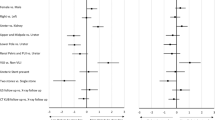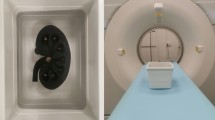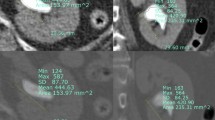Abstract
Several explanations have been suggested to account for the failure of extracorporeal shockwave lithotripsy (ESWL) treatment in patients with urinary stones, including large stone volume, unfavorable stone location or composition and the type of lithotriptor used. Unfavorable stone composition is considered a major cause of failure of ESWL treatment, and consequently knowledge of the stone composition before treatment is initiated is desirable. Plain abdominal radiographs cannot accurately determine either stone composition or fragility, and although the CT attenuation value in Hounsfield units (HU) (that is, normalized to the attenuation characteristics of water) is useful, this parameter has limited value as a predictor of stone composition or the response to ESWL treatment. By contrast, stone morphology as visualized by CT correlates well with both fragility and susceptibility to fragmentation by ESWL. For patients prone to recurrent calculi, analyses of stone composition are especially important, as they may reveal an underlying metabolic abnormality. The development of advanced imaging technologies that can predict stone fragility is essential, as they could provide extra information for physicians, enabling them to select the most appropriate treatment option for patients with urinary stones.
Key Points
-
The risk of urinary stone disease varies between 1% and 13% around the world and calcium oxalate lithiasis is the most common pathology worldwide
-
Knowledge of the stone composition can uncover underlying metabolic abnormalities and help urologists to provide optimal treatment and also prevent stone recurrence
-
Stone composition influences fragility, and thus knowledge of composition could enable urologists to predict the stone's susceptibility to fragmentation using extracorporeal shockwave lithotripsy (ESWL)
-
Plain abdominal radiography is incapable of determining stone composition, and the CT attenuation value in Hounsfield units (HU) has limited value for this purpose
-
Visualization of stone morphology on CT correlates well with susceptibility to ESWL, and could be used to select patients for this treatment
-
For patients prone to recurrent stones, chemical analysis of stones (either following spontaneous passage or after stone collection via ESWL or endoscopic procedures) is important
This is a preview of subscription content, access via your institution
Access options
Subscribe to this journal
Receive 12 print issues and online access
$209.00 per year
only $17.42 per issue
Buy this article
- Purchase on Springer Link
- Instant access to full article PDF
Prices may be subject to local taxes which are calculated during checkout

Similar content being viewed by others
References
Amato, M., Lusini, M. L. & Nelli, F. Epidemiology of nephrolithiasis today. Urol. Int. 72 (Suppl. 1), 1–5 (2004).
Lingeman, J. E. et al. Extracorporeal shock wave lithotripsy: the Methodist Hospital of Indiana experience. J. Urol. 135, 1134–1137 (1986).
Dretler, S. P. Stone fragility—-a new therapeutic distinction. J. Urol. 139, 1124–1127 (1988).
Williams, J. C. Jr, Paterson, R. F., Kopecky, K. K., Lingeman, J. E. & McAteer, J. A. High resolution detection of internal structure of renal calculi by helical computerized tomography. J. Urol. 167, 322–326 (2002).
Turgut, M. et al. The concentration of Zn, Mg and Mn in calcium oxalate monohydrate stones appears to interfere with their fragility in ESWL therapy. Urol. Res. 36, 31–38 (2008).
Madaan, S. & Joyce, A. D. Limitations of extracorporeal shock wave lithotripsy. Curr. Opin. Urol. 17, 109–113 (2007).
Ansari, M. S. et al. Stone fragility: its therapeutic implications in shock wave lithotripsy of upper urinary tract stones. Int. Urol. Nephrol. 35, 387–392 (2003).
Grases, F., Costa-Bauza, A. & Garcia-Ferragut, L. Biopathological crystallization: a general view about the mechanisms of renal stone formation. Adv. Colloid Interface Sci. 74, 169–194 (1998).
Ansari, M. S. et al. Spectrum of stone composition: structural analysis of 1050 upper urinary tract calculi from northern India. Int. J. Urol. 12, 12–16 (2005).
Krishnamurthy, M. S., Ferucci, P. G., Sankey, N. & Chandhoke, P. S. Is stone radiodensity a useful parameter for predicting outcome of extracorporeal shockwave lithotripsy for stones < or = 2 cm? Int. Braz. J. Urol. 31, 3–9 (2005).
Oehlschlager, S., Hakenberg, O. W., Froehner, M., Manseck, A. & Wirth, M. P. Evaluation of chemical composition of urinary calculi by conventional radiography. J. Endourol. 17, 841–845 (2003).
Teichman, J. M. Clinical practice. Acute renal colic from ureteral calculus. N. Engl. J. Med. 350, 684–693 (2004).
Wen, C. C. & Nakada, S. Y. Treatment selection and outcomes: renal calculi. Urol. Clin. North Am. 34, 409–419 (2007).
Joseph, P. et al. Computerized tomography attenuation value of renal calculus: can it predict successful fragmentation of the calculus by extracorporeal shock wave lithotripsy? A preliminary study. J. Urol. 167, 1968–1971 (2002).
Gupta, N. P., Ansari, M. S., Kesarvani, P., Kapoor, A. & Mukhopadhyay, S. Role of computed tomography with no contrast medium enhancement in predicting the outcome of extracorporeal shock wave lithotripsy for urinary calculi. BJU Int. 95, 1285–1288 (2005).
Ng, C. F. et al. Development of a scoring system from noncontrast computerized tomography measurements to improve the selection of upper ureteral stone for extracorporeal shock wave lithotripsy. J. Urol. 181, 1151–1157 (2009).
Perks, A. E. et al. Stone attenuation and skin-to-stone distance on computed tomography predicts for stone fragmentation by shock wave lithotripsy. Urology 72, 765–769 (2008).
Ferrandino, M. N. et al. Dual-energy computed tomography with advanced postimage acquisition data processing: improved determination of urinary stone composition. J. Endourol. 24, 347–354 (2010).
Dretler, S. P. & Spencer, B. A. CT and stone fragility. J. Endourol. 15, 31–36 (2001).
Stolzmann, P. et al. Dual-energy computed tomography for the differentiation of uric acid stones: ex vivo performance evaluation. Urol. Res. 36, 133–138 (2008).
Sheir, K. Z., Mansour, O., Madbouly, K., Elsobky, E. & Abdel-Khalek, M. Determination of the chemical composition of urinary calculi by noncontrast spiral computerized tomography. Urol. Res. 33, 99–104 (2005).
Zarse, C. A. et al. CT visible internal stone structure, but not Hounsfield unit value, of calcium oxalate monohydrate (COM) calculi predicts lithotripsy fragility in vitro. Urol. Res. 35, 201–206 (2007).
Evan, A. P., Willis, L. R., Lingeman, J. E. & McAteer, J. A. Renal trauma and the risk of long-term complications in shock wave lithotripsy. Nephron 78, 1–8 (1998).
Krambeck, A. E. et al. Diabetes mellitus and hypertension associated with shock wave lithotripsy of renal and proximal ureteral stones at 19 years of followup. J. Urol. 175, 1742–1747 (2006).
Baumann, J. M. Can the formation of calcium oxalate stones be explained by crystallization processes in urine? Urol. Res. 13, 267–270 (1985).
Ljunghall, S. & Hedstrand, H. Epidemiology of renal stones in a middle-aged male population. Acta Med. Scand. 197, 439–445 (1975).
Sutherland, J. W. Recurrence following operative treatment of upper urinary tract stone. J. Urol. 127, 472–474 (1982).
Strohmaier, W. L. Socioeconomic aspects of urinary calculi and metaphylaxis of urinary calculi [German]. Urologe A 39, 166–170 (2000).
Acknowledgements
We would like to thank Professor Amnuay Thithapandha for his help and advice concerning the preparation of this manuscript.
Author information
Authors and Affiliations
Contributions
K. Kijvikai researched data for the article. K. Kijvikai and J. J. M. de la Rosette were both involved in discussion regarding article content, writing of the article, and review and editing of the manuscript before submission.
Corresponding author
Ethics declarations
Competing interests
The authors declare no competing financial interests.
Rights and permissions
About this article
Cite this article
Kijvikai, K., de la Rosette, J. Assessment of stone composition in the management of urinary stones. Nat Rev Urol 8, 81–85 (2011). https://doi.org/10.1038/nrurol.2010.209
Published:
Issue Date:
DOI: https://doi.org/10.1038/nrurol.2010.209
This article is cited by
-
Predicting stone composition via machine-learning models trained on intra-operative endoscopic digital images
BMC Urology (2024)
-
Cerium oxide-based nanozyme suppresses kidney calcium oxalate crystal depositions via reversing hyperoxaluria-induced oxidative stress damage
Journal of Nanobiotechnology (2022)
-
Quantification and differentiation of composition of mixed pancreatic duct stones using single-source dual-energy CT: an ex vivo study
Abdominal Radiology (2019)
-
Complications of retrograde intrarenal surgery classified by the modified Clavien grading system
Urolithiasis (2018)
-
Clinical factors prolonging the operative time of flexible ureteroscopy for renal stones: a single-center analysis
Urolithiasis (2015)



